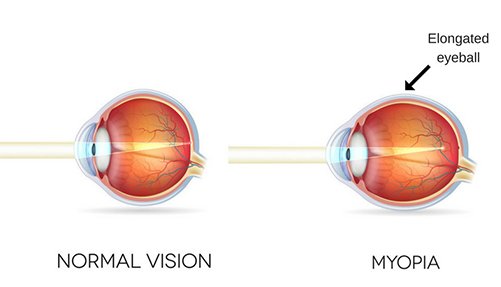What is Phakic IOL Implantation?
In the phakic intraocular lens (IOL) procedure, an intraocular lens is placed inside the eye, keeping the patient’s natural lens intact. This lens can be positioned either in front of or behind the iris, or it may be securely attached to the iris itself.
Phakic lens implants are a safe and effective choice for people with high myopia. These individuals can see well up close but have trouble seeing things far away. This option is also suitable for those with thin corneas who cannot undergo laser eye surgery. This procedure preserves the eye’s natural ability to focus by keeping the lens intact. It can also be reversed. This is different from Refractive Lens Exchange (RLE).
Phakic IOL procedures are for healthy patients. They are designed for those with severe nearsightedness. These patients should not have age-related vision problems or any eye diseases. Candidates should also have no abnormalities in the iris, pupil, or cornea, and no history of retinal detachment. Phakic IOL is a safer choice than refractive lens exchange for people with high myopia. It has a lower risk of retinal detachment.
What Is Myopia?
The cornea is the clear front part of the eye that bends light. The lens, behind the iris, helps to adjust this bending for clearer vision. Together, the cornea and lens work to focus incoming light onto the retina, enabling clear vision. In a myopic eye, the cornea is curved excessively, causing it to bend light too much. The light bends as it goes through the lens, causing it to focus in front of the retina.
This means that the light-sensitive cells in the retina do not receive a complete image. They send partial information to the brain through the optic nerve, which tries to understand this incomplete data and give it meaning.
Consequently, you experience blurry vision for distant objects, while close-up objects appear clear. This is because nearby objects require more light refraction than those that are far away. Your eyes can focus well on close objects but have trouble seeing distant ones clearly.

What Are the Potential Benefits of Phakic IOL Implantation?
- Clear to excellent distance vision without the need for contact lenses or glasses.
- The intraocular lenses (IOLs) are designed to be removable.
- Minimized risk of glare, halos, or issues with low lighting that may arise from high-intensity laser treatments.
- The natural lens remains intact, allowing patients under 40 years old to retain their near focusing ability.
How Does a Verisyse IOL Function in Comparison to LASIK?
This procedure works like LASIK surgery, both changing how your eyes bend light. However, in practice, it takes a different approach to achieve this objective.
LASIK works by vaporizing small sections of corneal tissue to flatten the curvature of the cornea. This new curvature allows light to bend in a way that provides clear vision at all distances.
A Verisyse IOL changes incoming light rays, improving the refraction done by the cornea and lens. This results in improved distance vision. Meanwhile, the eye’s natural lens adjusts for near vision by altering its curvature, a process known as accommodation.
What Are the Different Types of Phakic Intraocular Lenses (IOLs)?
Phakic intraocular lenses (IOLs) are particularly beneficial for individuals under the age of 45 who experience significant nearsightedness (myopia). These lenses provide a permanent solution without the need to remove the eye’s natural lens. The FDA has approved two types of phakic IOLs, and we will discuss which option is best suited for you during your visit.
- Visian ICL: This is a type of lens placed behind the colored part of your eye, above your natural lens, to help improve vision. Visian lenses are made from a safe material called Collamer®. They fit well with your eyes, providing comfort and reducing the chance of dry eye syndrome. Additionally, these lenses provide correction for astigmatism.
- Verisyse: This “anterior chamber” lens is placed in front of your iris rather than behind it. Made from a medical-grade polymer, its one-piece design allows for straightforward implantation. While less commonly used, it may be recommended in specific situations.
Similar to LASIK, the IOL placement procedure is quick. Most patients without corneal astigmatism can anticipate achieving vision of 20/40 or better following implantation.
Understanding The Verisyse Procedure
The procedure resembles cataract surgery more than LASIK, with the key difference being that your natural lens remains intact. This outpatient procedure typically lasts between 15 and 30 minutes. Doctors use a laser to make one or two tiny holes at the edge of the iris, which you cannot see. These perforations facilitate the movement of fluid between the areas behind and in front of the iris.
To prepare for the procedure, eye drops are administered to constrict your pupils, and anesthetic drops are used to numb your eyes. A small cut is made to insert the Verisyse lens. The lens is positioned in front of your iris and centered in front of the pupil and then attached to the iris for stability.
Many patients achieve better than 20/20 vision with a Verisyse IOL. Many reach 20/20 vision and are satisfied with the results.
What Can I Expect During Recovery and Postoperative Care?
The day following your surgery, you will come in for an office visit to ensure that you are healing properly. After the procedure, some patients might have blurry vision, while others see clearly. Each person’s healing process is different.
You can expect your vision to improve within a few days. After getting a phakic IOL, avoid heavy lifting and bending for the first four to seven days. You can go back to most activities after one week. However, avoid lifting heavy objects and swimming for the first month after your surgery.
Call SightMD to book an appointment with a doctor and discuss your vision health at a location near you!

Why Fall Is the Perfect Time to Consider LASIK Surgery
For many, the fall season marks a time of change. As the leaves change color and the weather gets…

Answering the Most Common Questions and Concerns about LASIK
LASIK eye surgery is a popular procedure that offers the promise of improved vision without the need for glasses…

Latest Advances in LASIK Eye Surgery
LASIK eye surgery is a popular choice for correcting vision problems such as nearsightedness, farsightedness, and astigmatism. At SightMD,…